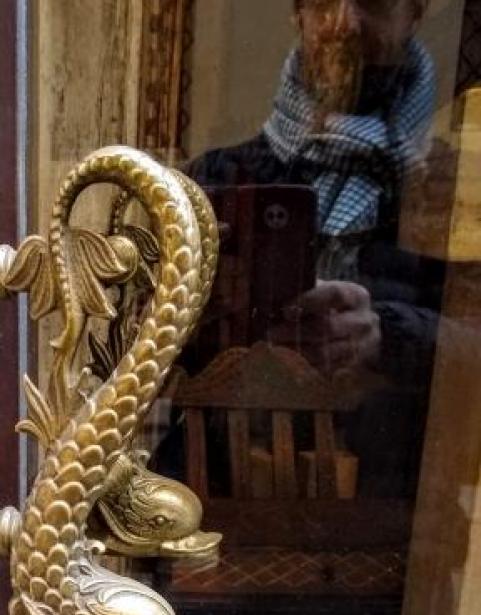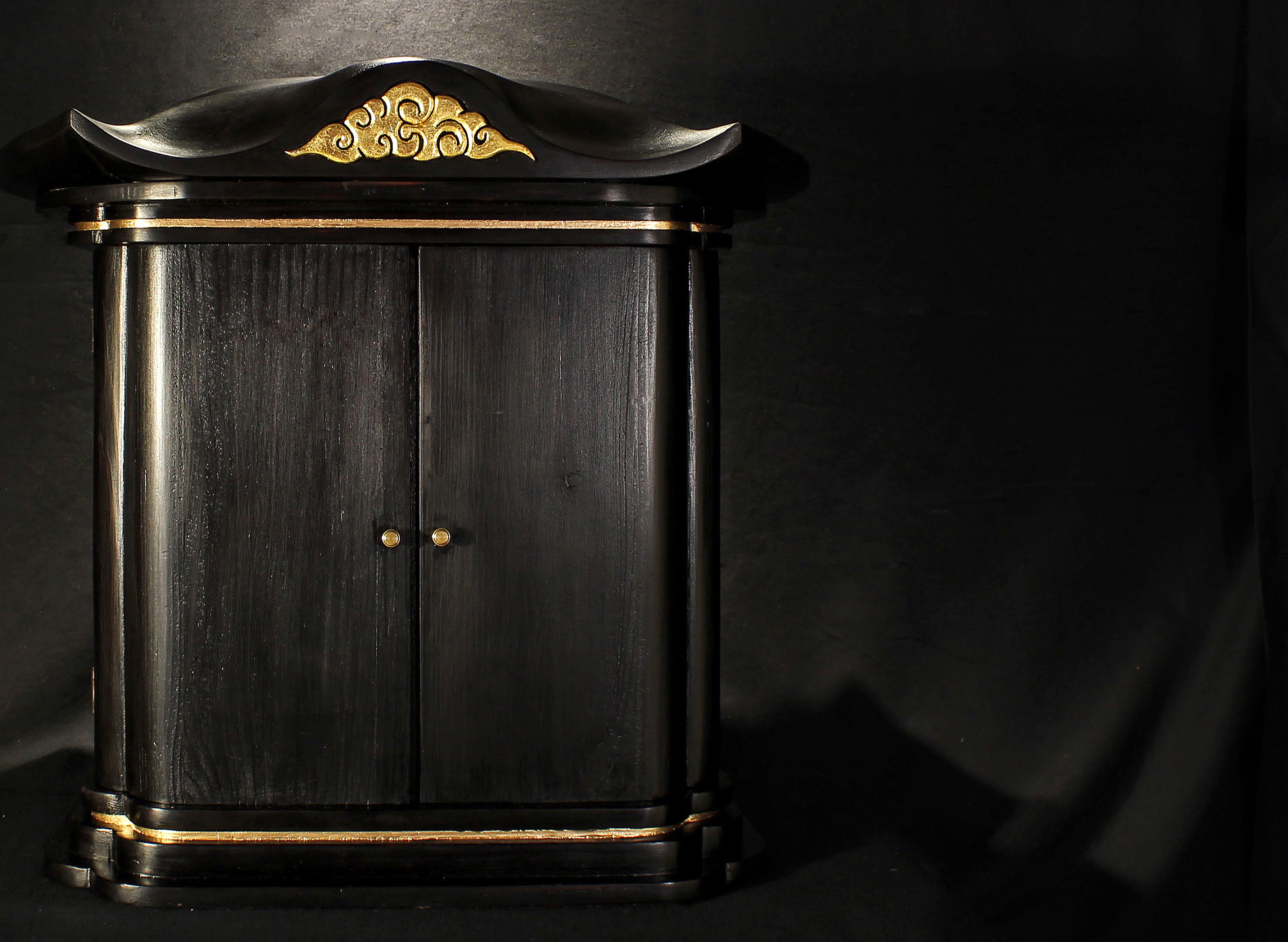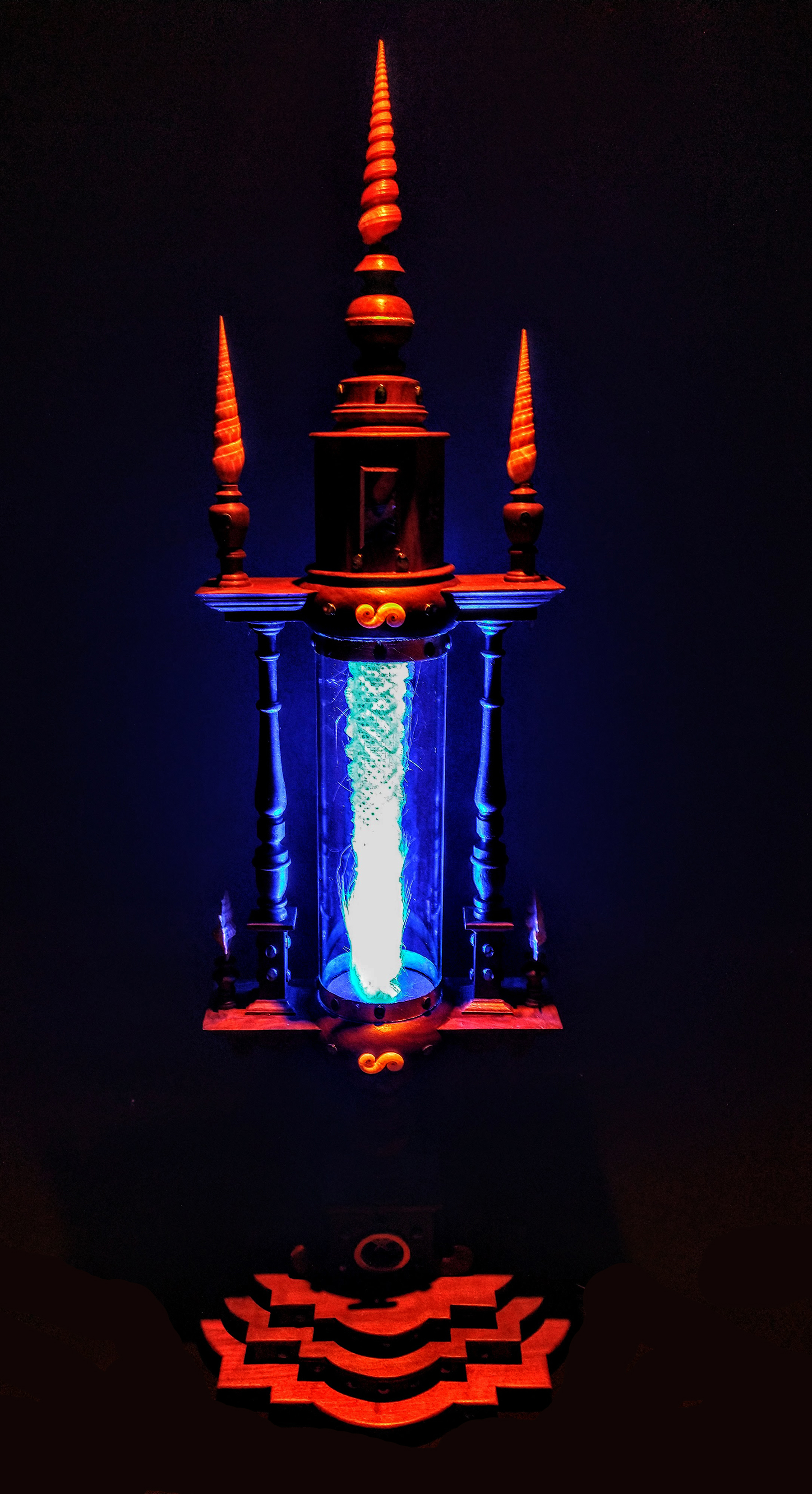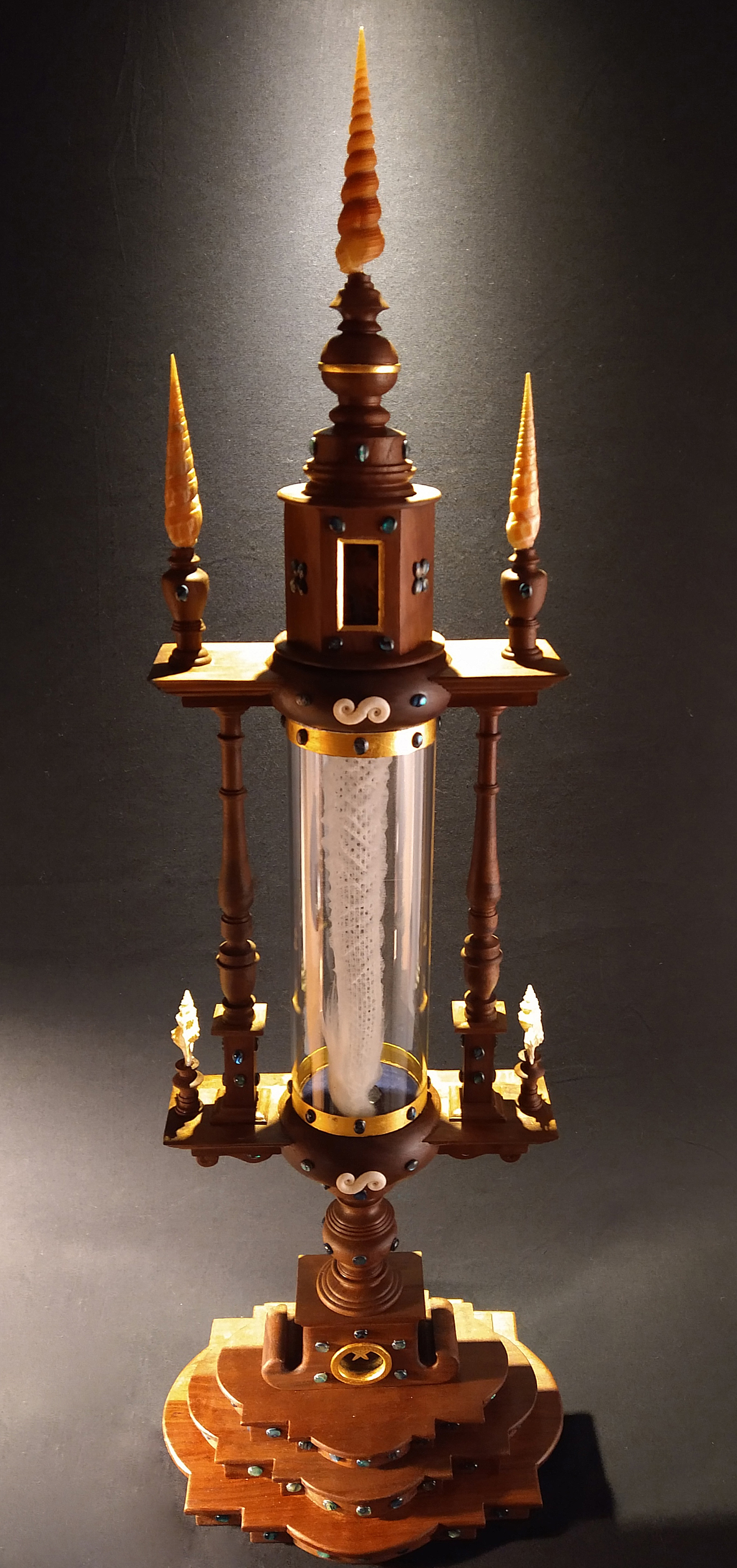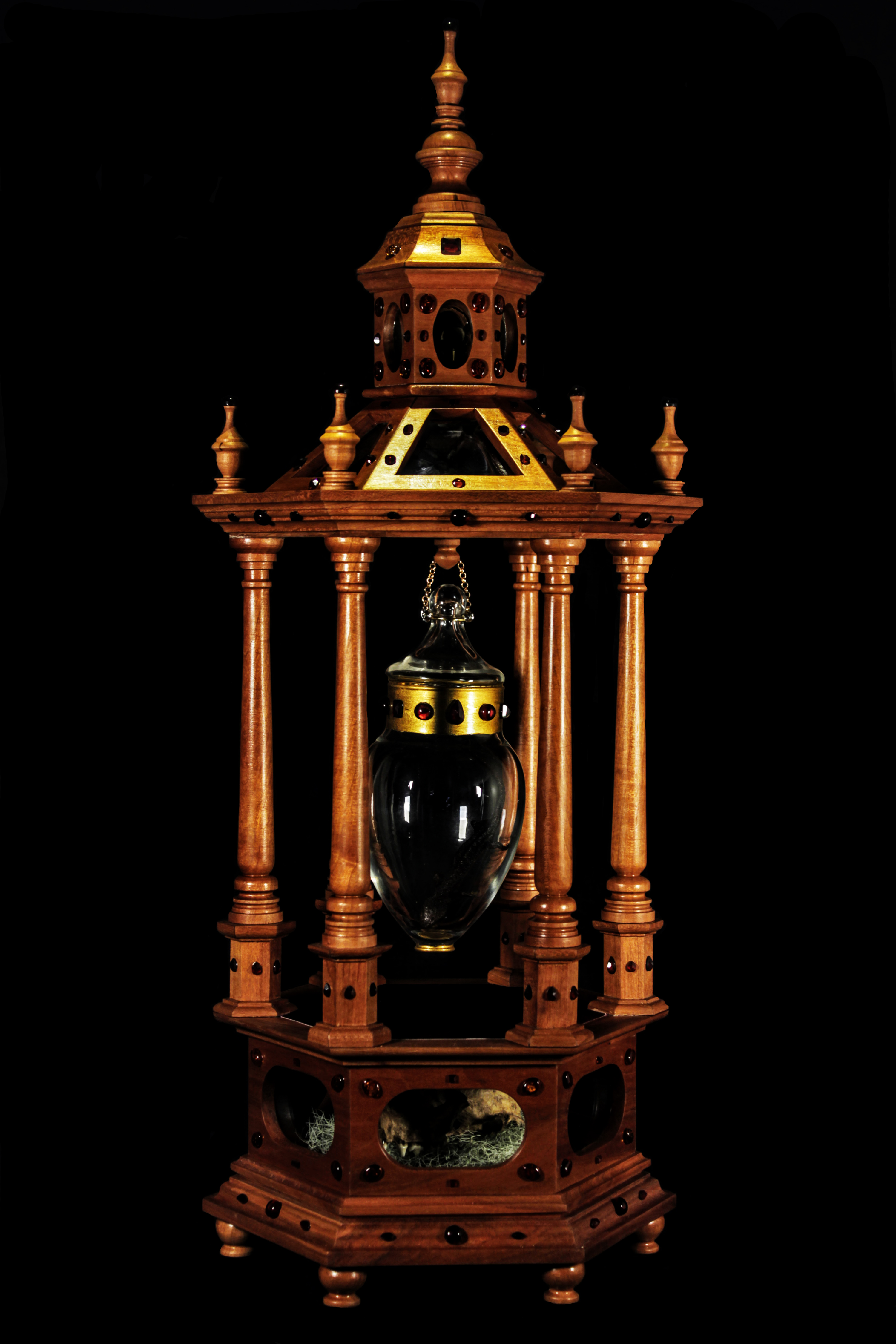Some years ago, Charles left a career as a research scientist in the environmental field to devote more time to a life-long interest in the visual arts. Near the end of his scientific career, his work was primarily focused on evaluating the coming impact of climate change on the Pacific Northwest; what he learned has had a lasting influence on his art. Charles, who has been making things with his hands since childhood, is an avid skier, traveler, musician, and museum-goer. He currently makes his home in Olympia, WA.
These works are a continuation of a series of intimate-scale shrines and reliquaries that contemplate what is truly sacred in our world, in an age of rapid climate change.
Some have said that humankind is “at war with nature”. As our planet warms and ice caps melt, we watch a 200-year collapse in biodiversity accelerate in ecosystems across the planet. With a changing climate we find ourselves facing an existential crisis unparalleled in human history, one that is permanently altering the natural world on a very, very short time scale. Every day I contribute to these changes.
I’m unsure at this point if we have the ability to significantly evolve our behavior of how we live on this planet, and our scientists have tried to warn us of the challenges that are coming regardless of the path we choose. I am convinced that if we are to succeed, it will require us to fundamentally redefine what we see and treat as sacred.
All my interests and skills seem to be colliding together in the artworks I make now, with these questions in mind. They are perhaps an eccentric blending of art history, natural science, environmental philosophy, architecture, Wunderkammer, and old-world craftsmanship. They are expressions of grief, expressions of wonder, and a quiet rage at the injuries we’re allowing to our home.
I’ve been looking at and thinking about art all my life, so the influences on how I see the world aesthetically are too long to list. In truth, my current work mostly pays homage to the anonymous artists and artisans from the past, from all cultures and religions, who also sought how to capture with their hands what was sacred in their world. To coax the viewer to join in seeing the sublime. I am in awe of their skill, and every day I work to learn more about the techniques these artists used to move their audience to extraordinary acts of sacrifice and dedication to cause. I try to remember that throughout history, shrines are as much functional objects of devotional practice as they are art objects intended to please the eye.
Although I am self-taught, I regularly consult with art historians, museum curators, and academics to learn more about the artworks and shrines from the past that inspire what I make next. While I clearly have access to tools that were unavailable for most of history (most notably computer modeling software and electric lighting), all my artworks are ultimately handcrafted in my studio.
Among many others, Holly Lane, Michael Garlington, and Andy Goldsworthy are modern artists that continue to help me see the world with fresh eyes. David Beck, a genius of renaissance skills, remains a favorite.
Flight (Zushi)
Mixed media - Western redcedar (Thuja plicata), Basswood (Tilia americana), Eastern black walnut (Juglans nigra), Chinese silk, 23K gold leaf, copper leaf, black shellac (Kerria lacca), Aurora morpho (Morpho aurora), Common blue morpho (Morpho helenor), Madagascar Sunset Moth (Urania ripheus); Tiger swallowtail (Papilio glaucus, f); Malaysian moon moth (Actias maenas), Albino luna moth (Actias luna?), Tailed sulphur (Phoebis neocypris), Aulestes doctor (Ancyluris aulestes), miscellaneous wings. Dimensions: 14” x 19” x 20”
In Japan, portable altars containing objects of worship are known as 'zushi'. These wooden box shrines appeared first in eighth-century Shinto temples, their small size allowing them to accompany their owner during travel. A central sculpture of a sacred Shinto or Buddhist deity is typically concealed behind humble black lacquer doors, enclosing an interior richly embellished with gold leaf, fine fabrics, carvings, and polychrome paintings. Opening the doors of these plain miniature temples gave the viewer a sudden sense of being in the presence of the divine. Visitors to such shrines would offer two sharp hand claps to honor the deity inside, often a god or goddess of compassion and mercy.
The traditional makers of zushi shrines excelled at using design elements that reflect the natural world - a stepped waterfall base symbolizing a sacred mountain landscape, cloud motif roofs and carvings evoking the sky above. 'Flight' honors the skill of these master artisans, while contemplating the impact of climate change on butterfly and moth species across the world.
The butterflies and moths hidden inside 'Flight' were found at a local flea market in a battered plexiglass display box. The Chinese silk was rescued from worn seat covers I purchased in an antique store many years ago.
Tempietto
Mixed media - Black cherry (Prunus serotina), Balkan amber, pyrope almandine garnets, silk moire, Rough-skinned newt (Taricha granulosa). Racoon (Procyon lotor), Eight-spotted skimmer dragonfly (Libellula forensis), Bumblebee (Bombus vandykei? f), Honey bees (Apis mellifera), Beard lichen (Usnea). Dimensions: 10” x 10” x 23”
In the early 1500's Donato Bramante designed a "martyria" temple to mark the location of the death of St. Peter in Rome. The 'Tempietto di Bramante', considered by many to be the finest example of High Renaissance architecture, employs the idealized geometric shapes of Greek antiquity to symbolize the divine perfection and harmony of heaven. The same architectural elements seen in Bramante's temple (the stylobate-colonnade-drum and-dome arrangement) were adopted in miniature by reliquary artists of northern Italy and Bavaria later in the 16th and 17th centuries to enshrine sacred relics.
The reduction in annual snowpack and increases in the severity of summer droughts being driven by climate change in the Pacific Northwest (and indeed across the world) threaten the long-term future of wetland habitats critical to the survival of a wide spectrum of amphibian species. Catastrophic collapses of amphibian populations have already been recorded across the planet in the last fifty years, with many species nearing extinction - climate change will only compound that trend.
The newt, raccoon, dragonfly, and bumblebee specimens enshrined in Tempietto were found adjacent to a wetland located near my home.
Secrets of the Past
Mixed media - Northern California claro walnut (Juglans hindsii); Venus flower basket glass sponge (Euplectella aspergillum), Japanese book cloth, 23K gold leaf, Screw turritella (Turritella terebra), Orange auger (Oxymeris dimidiata), Winged triton (Gyrineum perca), Starfish (Asteroidea), Abalone (Haliotidae), Ram's horn squid (Spirula spirula).
Dimensions: 8” x 10” x 32”
From as early as the 13th century, ostensoria (from the Latin ostendere:"to show") have been used in the Catholic church to protect and exhibit revered religious objects. The ostensoria created by artists in 16th-century northern Europe are among the finest known and have inspired this piece.
Glass sponges are remarkable deep ocean species - wonders of bioengineering. The woven glass spicules that comprise the framework of the sponge are derived from the conversion of silica acid from seawater. In some species of glass sponge, a breeding pair of deep-water shrimp are often trapped inside the interior of the sponge column, establishing a life-long symbiotic relationship. Perhaps inspired by this mutualism, glass sponges are given as wedding gifts in Japan to symbolize undying love.
Some species of glass sponge have been determined to be more than 10,000 years old - as a result, chemical analysis of the glass fibers can be used as a proxy for long-term changes in earth's climate and marine chemistry. Recent research suggests that warming temperatures and acidification of marine waters related to climate change could cause irreversible damage to Salish Sea glass sponge reefs in the coming years.
